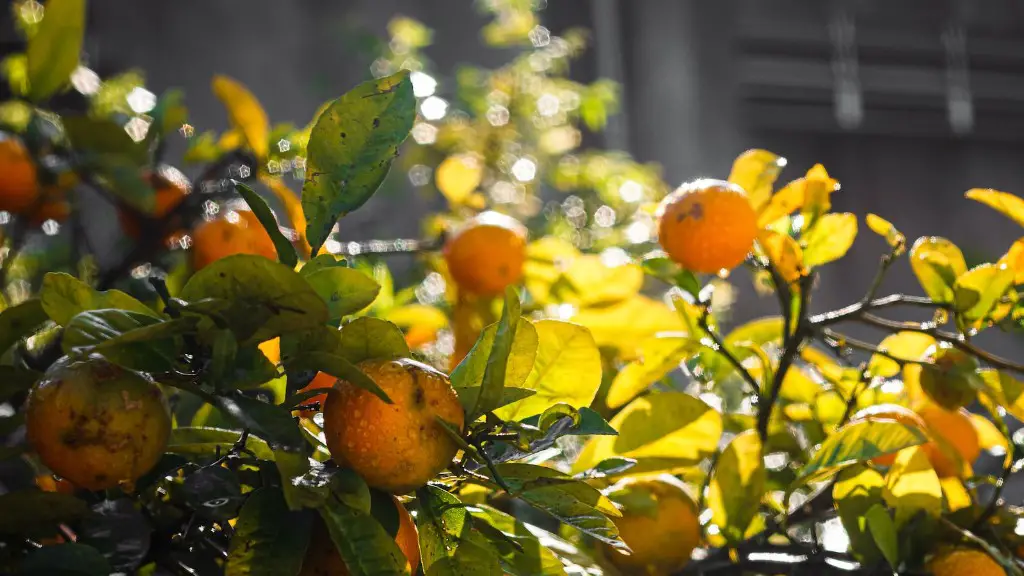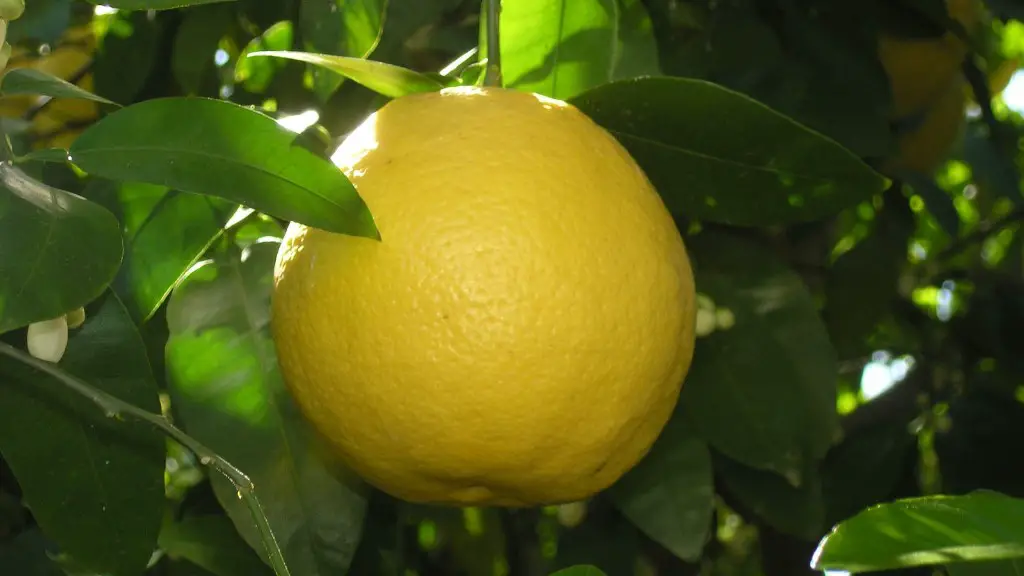Caring for a lemon tree begins from the moment the seed is sown; knowing how much to water it is a key factor for successful cultivation. There is no cut-and-dry answer to this question; the frequency of watering depends on many factors, and you must have a keen eye to detect the signs of dehydration and adjust your watering regime accordingly. Ultimately, the best way to determine how often to water your lemon tree is to observe it closely for signs of drought stress.
When watering your lemon tree, begin by assessing the soil’s moisture content. Stick your finger into the soil up to your knuckle; feeling the soil with your finger will help you detect if the soil is wet or dry. The frequency of watering depends on the local climate, the soil type and texture, the size of the tree, and how big the pot is. Generally, lemon trees thrive in moderate to high levels of humidity and sandy soil with good drainage; they need frequent waterings during the summer growing season, but this schedule will vary depending on your local climate.
For citrus trees, it is best to water deeply but infrequently, giving the soil time to dry out between waterings. The main goal is to ensure that the soil always stays at the same level of moistness. Go too long between irrigation and the soil may dry out completely, leading to root dehydration and eventual death of the tree; on the other hand, overwatering can also be deadly since it can lead to root rot. So water your lemon tree when the top inch of soil is dry to the touch, usually once per week.
In addition to regular watering, citrus trees benefit from being misted regularly as it raises the humidity level around the tree, promoting healthy growth and fruit production. Lastly, it is important to provide your lemon tree with sufficient nutrition. Citrus requires nitrogen to promote sun-licensed growth, as well as phosphate for plentiful blooms, and potash for optimal fruit production. Synthetic fertilizer or organic compost can be used to provide the necessary nutrients.
Managing Wind Damage in Lemon Trees
Wind can damage citrus trees, especially young trees that are not yet established. Since citrus trees are relatively shallow-rooted, they can be easily toppled by strong winds. To prevent wind damage, provide your lemon tree with adequate shelter so that it is protected from the wind. Plant them on the leeward side of a house or other tall structure, or use stakes, trellises, and supports to keep the tree upright.
In addition, you can use wind barriers such as burlap, shade cloth, or window screening to create a wind-proof barrier. This will protect the leaves from being burned by the wind or blown off, thereby driving down the amount of water needed on hot and windy days. Also, if your tree is showing any signs of wind damage, apply a generous layer of mulch around the base of the tree and ensure that it is adequately watered. By following these steps, you can protect your lemon tree from wind damage and keep it healthy.
Pruning Lemon Trees
Pruning is an important part of keeping citrus trees healthy and productive. Pruning is used to aid in the tree’s growth, shape, and vigor as well as to reduce the amount of work required for harvesting. Pruning is best done when the tree is still young, while it is easier to shape, and should be done sparingly and with respect to the natural growth pattern of the tree.
Begin pruning your lemon tree by removing dead and diseased branches, as well as any crossing and tangled branches. This will open up the tree’s canopy and ensure that light and air can reach the foliage and fruit. Prune the sides of the tree to form a V-shape, as this will help keep the tree healthy and the fruit accessible. Prune off any suckers or sprouts that are arising from near the base of the tree; these can rob the tree of energy and nutrients, leaving them unable to support healthy growth and fruit production.
Finally, you can shape your citrus tree by pruning to achieve a pleasing aesthetic. Remove any drought-damaged or wilting leaves, as well as any dead branches or leaves that are blocking light and air to the tree. When pruning, try to make clean cuts and avoid damaging the healthy parts of the tree. To keep your tree healthy, pruning should be done annually, with pruning of the sides and structure being done in late winter and other pruning in the summer months.
Handling Pest Infestations
The biggest pest for lemon trees is the cold-infesting mealybug, which has a whitish-gray colored coating over the body and secretes a syrupy substance called honeydew. If left untreated, mealybugs can cause yellowing and wilting of leaves, as well as weak, stunted growth in citrus trees. Thus, it is important to treat lemon trees at the first sign of a mealybug infestation.
To get rid of mealybugs, you will need to use a systemic insecticide or a natural insecticidal oil such as neem oil. To use the insecticide, mix it with water according to the instructions on the label and apply it to both the top and bottom sides of the leaves. If using neem oil, mix it with water according to the instructions and spray it directly onto the leaves and fruit. These insecticides should be applied every 7-10 days until the mealybug infestation is eliminated, and it is important to be vigilant in your treatment as mealybugs reproduce quickly.
Providing Shade for Your Lemon Tree
It is important to provide adequate shade for your citrus trees; too little shade can cause the leaves to burn or become diseased, while too much shade can suppress flowering and fruit production. To determine how much shade your lemon tree needs, look at the plants around it; if the plants are thriving in the area, that is a good indication that the same amount of shade will be sufficient for your citrus tree.
When providing a shade for your lemon tree, it is best to build a structure that has some slats for ventilation, such as a pallet frame. This will ensure that your citrus tree will get the sun it needs, while also providing protection from the hot midday sun. Also, make sure to install the shade structure at least 6 feet away from the trunk of the tree, as this will provide adequate air flow and prevent the tree from becoming water-logged.
Another way to provide shade for your lemon tree is to use thick plastic sheeting or burlap. This provides very good protection from the sun and can be rolled up over the summer months when less shade is needed. Shade cloths can also be used to drape over the tree and provide protection from the sun; just make sure to install it so that it is loose enough to allow air and light to reach the foliage.
Watering Lemon Trees During the Winter
One of the most challenging times of the year to water your lemon tree is during the winter months. This is because citrus trees require much less water during this time of year, as they go dormant and their natural evaporation rate is much lower. If you overwater your lemon tree during the winter months, it can lead to root rot and weakened the tree’s natural defenses against pests and disease.
So it is important to be mindful when watering your citrus tree in the winter and pay close attention to the soil’s moisture content. The frequency of watering in the winter should be reduced to as little as once a month, but if the weather is extremely dry then you may need to water more often. The best way to determine when to water is to check the soil with your finger or a trowel. If the top inch of soil feels dry to the touch, it is likely time to water; if it feels moist, then the tree likely still has enough moisture and you can wait a little longer before watering.
Protecting Lemon Trees From Frost Damage
Citrus trees are fairly hardy and should be able to endure normal winter temperatures without much trouble. However, in times of extreme cold, citrus trees can suffer frost damage leading to stunted growth, burn marks on the leaves, and even death of the tree.
Thus, it is important to be prepared for the cold months, and take measures to keep your lemon tree safe from the cold. One way to do this is to wrap the tree in a thick material such as burlap or shade cloth and keep it moist throughout the winter. This will help keep the tree warm, create a microclimate for it, and also provide some insulation from the cold.
Another way to protect your lemon tree from frost damage is to provide it with adequate shelter. Plant your lemon tree near walls, buildings, or other structures that will provide some protection. You can also use wind barriers such as shades or tree wraps to provide insulation and protection. Lastly, you can provide extra warmth to your lemon tree by applying mulch around its base; this will help keep the soil warmer and also provide some protection from the cold.


